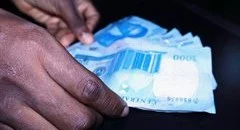Great race to State House proves costly for Kenya

Kenya is known for producing internationally acclaimed athletes, but many Kenyans and the world will remember the 2007 “race” to Kenya's State House – for a very long time, and for all the wrong reasons.
Several men and one woman were gunning for the highest job in the land: president of the Republic of Kenya. Ultimately, however, it was a battle between two main contenders - Emilio Mwai Kibaki (then the incumbent and currently president of Kenya) from the Party of National Unity (PNU) and Raila Amolo Odinga, from the Orange Democratic Movement (ODM).
Political analysts described the Kenyan general election as a “two-horse race” and it was. The third contender for the big job was Stephen Kalonzo Musyoka (ODM-Kenya), an underdog who put on a brave face while trying to keep up with the “big boys”.
Pollsters, led by Kenya research firm Steadman Group, conducted opinion polls during the months and weeks preceding the election and correctly predicted a hot contest between Kibaki and Raila. Two weeks before D-Day, Raila was leading by 43.6% compared to Kibaki's 43.3 %. Kalonzo was trailing at 11.4% - according to Steadman Group.
Media cashes in
The race was hot, the stakes high and the political environment was charged. Massive resources were poured into the political campaigns. The three main candidates launched aggressive campaigns and crisscrossed the country trying to convince the electorate why they were the best to lead them. They moved around with promises of better roads, jobs for the unemployed, free secondary-school education; one even promised to build an international airport in the arid north of Kenya - a part of the country inhabited by pastoralist communities and boasting little if any infrastructure, even roads. The region is so far removed from the rest of Kenya that the inhabitants even view themselves as “non-Kenyans”.
The media was the greatest beneficiary of the campaigns as money was poured into advertising and marketing in the electronic and print media. According to Steadman Group, 14 days to the election, adspend stood at KSh180.5 million and was expected to reach KSh200 million – and it might have surpassed the figure. In 2002, when the current president Kibaki was first elected to power, the adspend was KSh66.2 million.
Steadman figures showed PNU leading, having spent a whopping KSh126 million followed by KSh46 million and KSh2.7 million by ODM and ODM-Kenya respectively. Radio was the biggest recipient, with 49%, and television and print media was second and third with 31% and 19% respectively. Radio in Kenya is the most available form of mass media due to its wide coverage and reach. The various FM stations have segmented the population into niche markets – which were crucial during the election.
The political parties had developed slogans to stand for their agendas. PNU's was Kazi iendendelee (Swahili for “Development must continue” and the ODM used Chungwa Moja Maisha Bora (“One orange, better life”). Musicians also composed songs praising various presidential candidates.
Parties made extensive use of outdoor media with billboards, street banners and street lighting being mounted along major highways and streets around the country. And, of course, posters were slapped on just about any surface that could take one.
This year, the internet and mobile phones were also widely used. Phone ring tones and screen savers were developed and websites were uploaded with the political manifestos of the various parties. A lot of hate mail also did the rounds.
Apart from the political groups, the Electoral Commission of Kenya (ECK) also spent resources in civic education and used the mass media to teach voters how to vote and choose leaders wisely. Although the education exercise was not as aggressive as those of the political parties, the ECK spent a considerable amount on television and radio documentaries and outdoor advertising.
Maddening anxiety
Fast forward to Thursday December 27, 2007 when the official “race” to State House started. After months of campaigning, it was time… Kenyans turned up in large numbers to elect civic, parliamentary leaders and the president…
“I woke up at 5 am so I could vote. By 7.20 am I had voted and was returning home to wait for the results,” says Mary Njeri, a Nairobi resident. That enthusiasm was typical; Kenyan voters were charged and excited and the turnout was much better than that in previous years. According to the ECK, there were 14 million registered (eligible) voters in the country.
After voting, the long, anxious wait began. Most Kenyans followed the result on television, radio and the internet. The media camped at the various polling stations countrywide and aired minute-by-minute updates. In fact, the public often knew the results before the ECK – though according to the law, results are valid only after the ECK has authenticated and announced them.
Everyone was itching to know the presidential results. On Friday December 28 at 8:11 pm, Raila (ODM) was leading with 3.34 million votes with Kibaki trailing on 2.4 million, but as results from all 210 constituencies trickled in, the gap closed - increasing the tension. Saturday, December 29, and some 51 constituencies were yet to submit their results. It was day three and Kenyans still did not know their new president. Naturally, tension was mounting, and as the race was so close, the vote could swing either way and every vote (at the last minute could determine the final outcome.
Pressure started mounting as the ECK was urged to declare the winner, based on the votes they had received. The ECK commissioners were heckled and the chair, Samuel Kivuitu was told to sort out the delay as soon as possible. He complained of poor communication between the officials in the polling stations and the ECK headquarters. “We cannot reach some of the returning officers on phone,” he said. Some polling stations in the capital Nairobi had not forwarded their results, which further led to a delay.
By Sunday December 30, the ECK had still not announced results by midday – raising tensions even further. Finally, just before 6 pm the ECK declared Kibaki the winner with 4,584,721 votes compared to Odinga's 4,352,993 votes. It was a razor-sharp difference of 231,728 that led to over a week of violence in the country.
Moments later, after the ECK announcement, Kibaki was hurriedly sworn in at State House. But instead of the winners and losers living happily ever after, in a spilt second peaceful Kenya degenerated into chaos. Houses, businesses, vehicles and even a church went up in flames. And people died. There were allegations of massive rigging by both ODM and PNU. ODM believed its candidate had won the election while PNU insisted Kibaki was winner after ECK announced he had won by a majority vote.
Businesses remain shut
For almost a week, chaos and violence erupted around the country including the capital Nairobi. Ethnic communities that were thought to support the different political camps become instant targets in an explosion of violence that has so far claimed over 486 lives and displaced 255,686 people, according to official figures. As fighting rocked different parts of the country, most people chose to stay indoors and businesses closed.
As the rest of the world celebrated the New Year, Kenyans could only hope the New Year would bring peace. But instead of fireworks and parties on New Year's Eve, gunshots and screams filled the air in most parts of the country.
In Kisumu, rioters set fire to shops on the city's commercial thoroughfare, Odinga Odinga Street, and looted properties worth millions. The looting spree went on in the port of Mombasa, and in Eldoret, the agricultural town in the Rift Valley. Fortunately, the capital was spared as security personnel prevented any damage to Nairobi's central business district.
Apart from the looting and extensive destruction of property and loss of human life, the protesters also blocked the country's main road arteries so goods could not reach the consumers and even public service vehicles stopped operating, stranding passengers. The transport crunch also affected neighbouring Uganda and Rwanda, which both import their fuel through Kenya.
Most major supermarkets remained closed as perishable goods such as vegetables and milk spoilt on the shelves and had to be discarded. On some days, some shops opened for a limited time as just a few shoppers went in to buy essentials.
As the violence flared, Kenyans also experienced a temporary shortage of mobile phone airtime. Some traders cashed in and sold KSh100 airtime for KSh150 while others closed. There was also an acute shortage of food, especially fresh produce, so consumers turned to cereals, rice, beans and other non-perishables, stocking up just the violence continued.
Trading at the Nairobi Stock Exchange (NSE) was stopped last week Thursday, apparently because it could not guarantee the security of its staff or that of the stockbrokers.
In the last few years, consumer spending in Kenya has been on an upward trend with retail chain supermarket Nakumatt reporting impressive profits. Last year, consumer spending increased buy 14.6 to stand at KSh1.2 trillion.
However, the business community said the government was losing KSh 2 billion daily in lost revenues as businesses closed. Most manufactures are still recovering, as they had to stop operating completely or scale down operations due to transport hitches. Human resources have also been affected, as most people who had travelled to rural areas were unable to return to work.
As relative calm returns to the country, Kenya has many wounds to heal and we can only hope and pray for the best. God bless Kenya!























